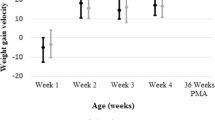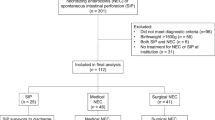Abstract
Objective:
To examine growth, neurodevelopment and morbidity in infants with gastroschisis.
Study Design:
We enrolled all infants with gastroschisis treated at the North Carolina Children's Hospital from March 2003 through June 2005. Neonatal data were collected. Medical history, growth and neurodevelopment were assessed at 16 to 24 months.
Result:
Of 24 infants, 17 completed follow-up. Weight and length were below the 10th percentile for five and six infants, respectively. Three infants scored less than 85 on the Bayley Scales of Infant Development, second edition. Small for gestational age (SGA) infants were smaller and had lower neurodevelopmental scores. Fourteen experienced continued bowel dysfunction; nine were rehospitalized.
Conclusion:
One-third of infants with gastroschisis experience growth delay. Infants who are SGA are at higher risk, suggesting that postnatal growth may be influenced by fetal phenomena, and may not be modifiable. Neurodevelopment is not delayed. Continued bowel dysfunction is common.
This is a preview of subscription content, access via your institution
Access options
Subscribe to this journal
Receive 12 print issues and online access
$259.00 per year
only $21.58 per issue
Buy this article
- Purchase on Springer Link
- Instant access to full article PDF
Prices may be subject to local taxes which are calculated during checkout
Similar content being viewed by others
References
Laughon M, Meyer R, Bose C, Wall A, Otero E, Heerens A et al. Rising birth prevalence of gastroschisis. J Perinatol 2003; 23 (4): 291–293.
Singh SJ, Fraser A, Leditschke JF, Spence K, Kimble R, Dalby-Payne J et al. Gastroschisis: determinants of neonatal outcome. Pediatr Surg Int 2003; 19 (4): 260–265.
Driver CP, Bruce J, Bianchi A, Doig CM, Dickson AP, Bowen J . The contemporary outcome of gastroschisis. J Pediatr Surg 2000; 35 (12): 1719–1723.
Eggink BH, Richardson CJ, Malloy MH, Angel CA . Outcome of gastroschisis: a 20-year case review of infants with gastroschisis born in Galveston, Texas. J Pediatr Surg 2006; 41 (6): 1103–1108.
Clayton PE, Cianfarani S, Czernichow P, Johannsson G, Rapaport R, Rogol A . Management of the child born small for gestational age through to adulthood: a consensus statement of the International Societies of Pediatric Endocrinology and the Growth Hormone Research Society. J Clin Endocrinol Metab 2007; 92 (3): 804–810.
Puligandla PS, Janvier A, Flageole H, Bouchard S, Mok E, Laberge JM . The significance of intrauterine growth restriction is different from prematurity for the outcome of infants with gastroschisis. J Pediatr Surg 2004; 39 (8): 1200–1204.
Blakelock RT, Harding JE, Kolbe A, Pease PW . Gastroschisis: can the morbidity be avoided? Pediatr Surg Int 1997; 12 (4): 276–282.
Berseth CL, Malachowski N, Cohn RB, Sunshine P . Longitudinal growth and late morbidity of survivors of gastroschisis and omphalocele. J Pediatr Gastroenterol Nutr 1982; 1 (3): 375–379.
Davies BW, Stringer MD . The survivors of gastroschisis. Arch Dis Child 1997; 77 (2): 158–160.
Swartz KR, Harrison MW, Campbell JR, Campbell TJ . Long-term follow-up of patients with gastroschisis. Am J Surg 1986; 151 (5): 546–549.
Lunzer H, Menardi G, Brezinka C . Long-term follow-up of children with prenatally diagnosed omphalocele and gastroschisis. J Matern Fetal Med 2001; 10 (6): 385–392.
Boyd PA, Bhattacharjee A, Gould S, Manning N, Chamberlain P . Outcome of prenatally diagnosed anterior abdominal wall defects. Arch Dis Child Fetal Neonatal Ed 1998; 78 (3): F209–F213.
Cywes S, Davies MR . Complications and follow-up of gastroschisis. S Afr Med J 1979; 55 (13): 499–501.
Fenton TR . A new growth chart for preterm babies: Babson and Benda's chart updated with recent data and a new format. BMC Pediatr 2003; 3: 13.
Kuczmarski RJ, Ogden CL, Grummer-Strawn LM, Flegal KM, Guo SS, Wei R et al. CDC growth charts: United States. Adv Data 2000; 8 (314): 1–27.
Bayley N . Bayley Scales of Infant Development, 2nd edn. Psychological Corporation: San Antonia, TX, 1993.
Voskuijl WP, Heijmans J, Heijmans HS, Taminiau JA, Benninga MA . Use of Rome II criteria in childhood defecation disorders: applicability in clinical and research practice. J Pediatr 2004; 145 (2): 213–217.
Rasquin-Weber A, Hyman PE, Cucchiara S, Fleisher DR, Hyams JS, Milla PJ et al. Childhood functional gastrointestinal disorders. Gut 1999; 45 (Suppl 2): II60–II68.
Stein RE, Jessop DJ . Functional status II(R). A measure of child health status. Med Care 1990; 28 (11): 1041–1055.
Mahour GH, Lee FA . Gastroschisis: mortalities, and growth of survivors. Am Surg 1974; 40 (7): 425–427.
Hediger ML, Overpeck MD, McGlynn A, Kuczmarski RJ, Maurer KR, Davis WW . Growth and fatness at three to six years of age of children born small- or large-for-gestational age. Pediatrics 1999; 104 (3): e33.
Gortner L, van Husen M, Thyen U, Gembruch U, Friedrich HJ, Landmann E . Outcome in preterm small for gestational age infants compared to appropriate for gestational age preterms at the age of 2 years: a prospective study. Eur J Obstet Gynecol Reprod Biol 2003; 110 (Suppl 1): S93–S97.
McCarton CM, Wallace IF, Divon M, Vaughan Jr HG . Cognitive and neurologic development of the premature, small for gestational age infant through age 6: comparison by birth weight and gestational age. Pediatrics 1996; 98 (6 Part 1): 1167–1178.
Pryor J, Silva PA, Brooke M . Growth, development and behaviour in adolescents born small-for-gestational-age. J Paediatr Child Health 1995; 31 (5): 403–407.
Ginn-Pease ME, King DR, Tarnowski KJ, Green L, Young G, Linscheid TR . Psychosocial adjustment and physical growth in children with imperforate anus or abdominal wall defects. J Pediatr Surg 1991; 26 (9): 1129–1135.
Owen A, Marven S, Jackson L, Antao B, Roberts J, Walker J et al. Experience of bedside preformed silo staged reduction and closure for gastroschisis. J Pediatr Surg 2006; 41 (11): 1830–1835.
Tunell WP, Puffinbarger NK, Tuggle DW, Taylor DV, Mantor PC . Abdominal wall defects in infants. Survival and implications for adult life. Ann Surg 1995; 221 (5): 525–528; discussion 8–30.
Acknowledgements
This research was funded solely through departmental funds.
Author information
Authors and Affiliations
Corresponding author
Additional information
Financial disclosures
We have no financial relationships relevant to this article to disclose.
Rights and permissions
About this article
Cite this article
South, A., Marshall, D., Bose, C. et al. Growth and neurodevelopment at 16 to 24 months of age for infants born with gastroschisis. J Perinatol 28, 702–706 (2008). https://doi.org/10.1038/jp.2008.71
Received:
Revised:
Accepted:
Published:
Issue Date:
DOI: https://doi.org/10.1038/jp.2008.71
Keywords
This article is cited by
-
Longitudinal growth of children born with gastroschisis or omphalocele
European Journal of Pediatrics (2023)
-
Outcome and management in neonates with gastroschisis in the third millennium—a single-centre observational study
European Journal of Pediatrics (2022)
-
Growth and risk of adverse neurodevelopmental outcome in infants with congenital surgical anomalies: a systematic review
Pediatric Surgery International (2022)
-
Growth restriction in gastroschisis: quantification of its severity and exploration of a placental cause
BMC Pediatrics (2011)
-
Hospital readmission among infants with gastroschisis
Journal of Perinatology (2011)



